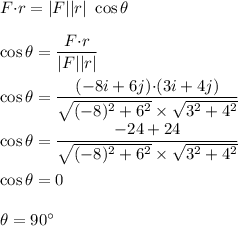
Physics, 19.03.2020 02:30, taylorbug6161
Force → F = ( − 8.0 N ) ˆ i + ( 6.0 N ) ˆ j acts on a particle with position vector → r = ( 3.0 m ) ˆ i + ( 4.0 m ) ˆ j . What are (a) the torque on the particle about the origin, in unit-vector notation, and (b) the angle between the directions of → r and → F ?

Answers: 2
Other questions on the subject: Physics

Physics, 22.06.2019 15:00, bagofmud8339
When is a current produced? when the terminals of an electrochemical cell are connected by a wire if the electric circuit is opened in an electrochemical cell if the electrolyte is removed from an electrochemical cell when the electrodes are reversed in an electrochemical cell
Answers: 3

Physics, 22.06.2019 18:30, ochoanene822
Which of the following is not a means to accelerating? question 4 options: a)increase speed b)remain still c)decrease speed d)change direction
Answers: 2

Physics, 23.06.2019 07:00, coollid876
Acircuit contain a 5-ohm, a3-ohm, and an 8-ohm resistor in series. what is the total resistance of the circuit
Answers: 2

Physics, 23.06.2019 12:30, maskoffvon
Give an example of a collision in real life. use the law of conservation of energy to describe the transfer of momentum. be sure and discuss the momentum before and after the collision occurs. you will need at least 3 sentences to thoroughly answer this question
Answers: 3
Do you know the correct answer?
Force → F = ( − 8.0 N ) ˆ i + ( 6.0 N ) ˆ j acts on a particle with position vector → r = ( 3.0 m )...
Questions in other subjects:

Business, 03.08.2019 22:30

Mathematics, 03.08.2019 22:30






Biology, 03.08.2019 22:30


Social Studies, 03.08.2019 22:30










